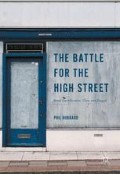Abstract
In this book, Mary Portas’ review of High Streets, commissioned by the British government in 2011, has been taken to encapsulate much that appears to be taken as axiomatic in current thinking about the High Street. In this review, she argued the British High Street was declining alarmingly. For her, this was about more than simply the shift of retailing out of town and online, concerning the decline of community, and the evisceration of urban life:
Access this chapter
Tax calculation will be finalised at checkout
Purchases are for personal use only
References
Amin, A. (2010). Cities and the ethic of care for the stranger. Joint Joseph Rowntree Foundation/University of York Annual Lecture. York: Joseph Rowntree Foundation.
Amin, A. (2013). Land of Strangers. Chichester: John Wiley.
Atkinson, R. (2003). Domestication by cappuccino or a revenge on urban space? Control and empowerment in the management of public spaces. Urban Studies, 40(9), 1829–1843.
Bauman, Z. (2011). Interview—Zygmunt Bauman on the UK riots. Social Europe Journal, Online Edition. Retrieved from www.social-europe.eu/2011/08/interview-zygmunt-bauman-on-the-uk-riots/
Carmona, M. (2014). London’s local High Streets: The problems, potential and complexities of mixed street corridors. Progress in Planning,100, 1–84.
Coleman, R. (2004). Watching the degenerate: CCTV and urban regeneration. Local Economy, 19(3), 199–211.
Department of Communities and Local Government (DCLG) (2013). The future of High Streets. London: DCLG.
Dorling, D., & Lee, C. (2014). Inequality constitutes a particular place. In D. Pritchard & F. Pakes (Eds.), Riot, unrest and protest on the global stage. Palgrave Macmillan: Basingstoke.
Findlay, A., & Sparks, L. (2012). Far from the ‘Magic of the Mall’: Retail (change) in ‘other places’. Scottish Geographical Journal, 128(1), 24–41.
Grimsey, B. (2013) The Grimsey Review: An alternative future for the High Street. Retrieved from www.vanishinghighstreet.com
Hall, S. M. (2011). High Street adaptations: Ethnicity, independent retail practices, and localism in London’s urban margins. Environment and Planning A, 43(11), 2571–2588.
Hall, S. M. (2012). City, street and citizen: The measure of the ordinary. London: Routledge.
Hall, S. M. (2013). Future of London’s town centres: Submission to the London Assembly’s Planning Committee. London: LSE Cities.
Hatherley, O. (2011) Looking at England’s urban spaces, the riots were inevitable, https://www.opendemocracy.net/ourkingdom/owen-hatherley/look-at-englands-urban-spaces-riots-were-inevitable 17 August.
Haylett, C. (2001). Illegitimate subjects? Abject whites, neoliberal modernisation and middle class multiculturalism. Environment and Planning D: Society and Space., 19(3), 351–370.
Hentschel, C., & Blokland, T. (2016). Life and death of the great regeneration vision: Diversity, decay, and upgrading in Berlin’s ordinary shopping streets. In S. Zukin, P. Kasinitz, & X. Chen (Eds.), Global cities, local streets. New York: Routledge.
High Street London (2010). High Street London. London: GLA.
Hubbard, P. (2006). Key ideas in Geography—The City. London: Routledge.
Hunt, M. (2015). Keeping shop, shaping place: The vernacular curation of London’s ad hoc consumption spaces. PhD, Royal Holloway, University of London.
Jones, H., Neal, S., Mohan, G., Connell, K., Cochrane, A., & Bennett, K. (2015). Urban multiculture and everyday encounters in semi-public, franchised café spaces. The Sociological Review, 63(44), 644–661.
Kasinitz, P., & Zukin, S. (2016). From ghetto to global: Two neighbourhood shopping streets in New York City. In S. Zukin, P. Kasinitz, & X. Chen (Eds.), Global cities, local streets. New York: Routledge.
Kuppinger, P. (2014). A neighborhood shopping street and the making of urban cultures and economies in Germany. City & Community, 13(2), 140–157.
Lefebvre, H. (1991). The production of space. Oxford: Blackwell.
Local Data Company. (2012). H2 vacancy rate report. London: Local Data Company.
Paton, K. (2014). Gentrification: A working class perspective. Farnham: Ashgate.
Portas, M. (2011). The Portas review: An independent review into the future of our High Streets. http://www.maryportas.com/news/2011/12/12/the-portas-review/
Ravenscroft, N. (2000). The vitality and viability of town centres. Urban Studies, 37(13), 2533–2549.
Schulman, S. (2012). The gentrification of the mind: Witness to a lost imagination. Berkeley: University of California Press.
Shields, R. (1991). Places on the margin. London: Routledge.
Skeggs, B. (2009). The moral economy of person production: The class relations of self-performance on ‘reality’ TV. The Sociological Review, 57(4), 626–644.
Slater, T. (2006). The eviction of critical perspectives from gentrification research. International Journal of Urban and Regional Research, 30(4), 737–757.
Townshend, T. G. (2016). Toxic High Streets. Journal of Urban Design, online early, doi:10.1080/13574809.2015.1106916
Tyler, I. (2013). The riots of the underclass? Stigmatisation, mediation and the government of poverty and disadvantage in neoliberal Britain. Sociological Research Online, 18(4), 6.
Wacquant, L. (2008). Relocating gentrification: The working class, science and the state in recent urban research. International Journal of Urban and Regional Research, 32(1), 198–205.
Wrigley, N., & Dolega, L. (2011). Resilience, fragility and adaptation: New evidence on the performance of UK High Streets during global economic crisis and its policy implications. Environment and Planning A, 43(10), 2337–2363.
Zukin, S., & Kosta, E. (2004). Bourdieu off-Broadway: Managing distinction on a shopping block in the East Village. City & Community, 3(2), 101–114.
Author information
Authors and Affiliations
Copyright information
© 2017 The Author(s)
About this chapter
Cite this chapter
Hubbard, P. (2017). Conclusion: Vital and Viable?. In: The Battle for the High Street. Palgrave Macmillan, London. https://doi.org/10.1057/978-1-137-52153-8_10
Download citation
DOI: https://doi.org/10.1057/978-1-137-52153-8_10
Published:
Publisher Name: Palgrave Macmillan, London
Print ISBN: 978-1-137-52152-1
Online ISBN: 978-1-137-52153-8
eBook Packages: Social SciencesSocial Sciences (R0)

